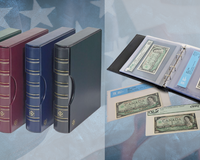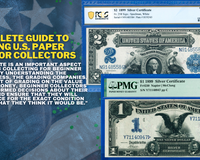In this day and age, people have the option of using digital payment methods to complete their transactions without using physical currency. This is because of the ongoing development of payment technologies. You'll notice that credit cards and other electronic payment methods are taking the place of physical paper money, which is appearing less and less.
A person who enjoys the nostalgia of things from the past and history. For most of the people, paper money is not just a monetary payment unit but also a collectible item that tells a lot about its history through its design and the date of issue. There is a wide range of people who, like myself, are fascinated by the designs applied to the notes, which include intricate ornate, allegorical images, significant historical moments, elaborate carvings, and portraits of our country's great people.
Collecting U.S. paper money is an opportunity to learn about the country's history and the lives of those who lived before us. It is a way to recognize the accomplishments and passions of past generations and preserve that history for future generations. The choice of what to collect is highly personal and depends on the collector's interests, budget, and other factors. Regardless of what one chooses to collect, U.S. paper money offers a unique window into the past, making it a truly fascinating hobby.
Starting collect U.S Currency by Paper Sizing:
U.S. paper Money comes in two distinct sizes, each with its own unique characteristics and history. Before 1929, all U.S. paper money was printed as large-sized notes with dimensions of approximately 7 3/8 inches by 3 1/8 inches. These notes were often elaborately designed, showcasing intricate artwork and portraits of important figures.

However, in 1929, Treasury Secretary Andrew W. Mellon approved a recommendation to reduce the costs of production, paper, and ink, as well as to speed up printing production. As a result, a new series of small-sized U.S. currency was introduced with dimensions of approximately 6 1/8 inches by 2 5/8 inches. This smaller size allowed for more efficient production and became the standard for U.S. paper money that we still use today.
While the large-sized notes remained legal tender, they were gradually withdrawn and replaced with their smaller counterparts. For collectors, both small-sized and large-sized U.S. paper money offers a unique look into the history of currency and the various factors that have influenced its design and production over time.
Collecting by Type:
The concept of collecting paper money may appear difficult at first because of the seemingly limitless avenues of collection. Collectors are encouraged to find the types of paper money that interest them and explore from there. Since the first U.S. paper money was printed in the 1690s until now, there has been a wide variety type of U.S. paper money released throughout a three-hundred-year span.
- Obsolete Bank Notes: These were issued from 1782 until 1866 by most of the banks across the country.
- Legal Tender Notes or United States Note: The first was issued back in 1862 with the purpose to pay any expense incurred by the civil war.

- National Bank Note: These notes were first issued in the 1863s and lasted until the 1935s by over 12.000 national banks throughout the U.S. and in U.S. Territories during this time.
- Federal Reserve Note: This type is the currency that we are using today. It was issued by Federal Reserve System with the first release in 1914.
- Federal Reserve Bank Note: Authorized by the Act of December 23 1913 and labeled “National Currency”. Debut with the first series issued in 1915 in denominations of $5, $10, and $20, using a design that shared elements with both the National Bank Notes and the Federal Reserve Notes of the time.
- Treasury Note: This type of currency also bearing with another name “Coin Notes”. It was only issued in a short period with a series of 1890 and 1891. These notes were backed by precious metals and could be redeemed by gold or silver coin.
- Gold Certificate: was first authorized under the Legal Tender Act of 1863. These notes used to be redeemable for a certain amount of gold coins equally the value. This type of currency was also famous with the nickname “Goldbacks” due to its vibrant ornate back design.

- Silver Certificate: The first silver certificates were issued from 1878 until 1964. This kind of currency was backed by silver bullion in the treasury stockpile. The type of silver certificates varied in design, and color making them one of the most fascinating and favorite designs ever among the numismatic community.
Collecting by Denomination:
Nowadays, the U.S Paper Money system only consisted of seven denomination which is $1, $2, $5, $,10, $20, $50, and $10. However, back in that day, there were other higher denominations which were $500, $1000, $5000, and even $10.000.
The high denomination notes ($500, $1,000, $5,000, and $10,000) of U.S. paper money are considered rare and highly collectible due to their limited circulation. The front of these notes typically feature portraits of prominent individuals from American history, such as William McKinley, Grover Cleveland, James Madison, and Salmon P. Chase.
The fact that they were no longer printed by the Federal Reserve since 1945 and were officially withdrawn from circulation by the Federal Reserve in 1969 due to the lack of use and increasing concerns about organized crime.
The first two large denominations $500 and $1000 can be easily found in the numismatic market today. The value crossed the line for the $5000 and $10.000 and was too far away from the basic face value. There is also a group of people who tend to collect all types of U.S Currency for only one denomination.
Collecting by the state or bank from the National Bank Note:
Collecting U.S. Paper Money by the state or bank from the National Bank Note is another popular way to categorize a collection. These notes were first issued in the 1863s and lasted until the 1935s by over 12.000 national banks throughout the U.S. and in U.S. Territories during this time
The National Currency or Bank Note was backed by U.S Bonds which meant that the national banks had to deposit an amount to the U.S Treasury and they have the right to issue their own currency up to 90% of their holdings of U.S Bonds with the bank’s name, town and also the Charter given by the U.S Government.
It can be said that this is a complicated type of paper money and also attracts a lot of collectors in the numismatic community. Also, there was another group of people tend to collect the note which had the state or bank printed on the notes indicating their hometown or city.
Star Note or Replacement Note:
A Star note means the replacement note was used to replace the actual note which had the printing mistake occur during the printing process. By their nature, star notes are extremely scarcer than notes with standard serial numbers and as such are widely collected by numismatists.

Collectors consider star notes to be a unique and valuable addition to their collection, as they are considered rarer than regular notes. There is also a limited number of star notes produced for each series, making them a valuable commodity to collectors.
Block Letter Collecting:
The concept of collecting US Small Size Paper Money by block letters involves grouping notes based on the first and last letters that encapsulate the eight-digit serial number. This allows collectors to categorize and track the progress of their collection as block letters move across the alphabet as more notes are printed.

Each block letter combination has a finite number of possible serial numbers, making some combinations rarer than others. This scarcity can lead to increased interest and demand for certain block letters, making block letter collecting a unique and dynamic hobby.
Significant Figure
The design of large-sized US paper money is complex and often features portraits of significant figures, as well as intricate engravings, vignettes, and seals. Some collectors focus specifically on notes that feature a portrait of a significant figure, such as Abraham Lincoln or Alexander Hamilton. There are several reasons why people tend to collect these notes.
One of the reasons is to commemorate the life and achievements of the person depicted on the note. These historical figures often played important roles in shaping the course of history and collecting notes featuring their portraits is a way of preserving and paying homage to their legacy.

Another reason why people collect these notes is due to their historical significance. By collecting these notes, collectors can learn about the past and gain a deeper appreciation for the events and people that helped shape our country.
Signature
The signature combination on U.S. paper money refers to the signatures of the officials who sign the notes. Most of U.S Currency which are Federal Reserve Notes, Treasury Notes, and National Bank Notes, Silver Certificates typically have two signatures, one of the Register of the Treasury and one of the Treasurer of the United States.

The Federal Reserve Bank Notes had an extra two signatures: the Cashier and Governor of each twelve Federal Reserve Bank.

There is also a group of collectors who tend to collect issues of a particular signature from a person or combination of the two signers. The combination of signatures on a note can affect its value to collectors, as certain combinations may be scarcer or more desirable.
Stunning Design In Terms of Art
The U.S. paper money collecting is not just about the value of the currency, and scarcity but also about the design, history, and cultural significance of each note. The intricate designs applied to old U.S. currency for several reasons.

Firstly, the intricate designs, colors, and subject matter of the bills give them an aesthetic appeal that is visually stunning and is an attempt to fend off counterfeiters. And that's what makes these notes become a masterpiece of art. Secondly, the design and production process was highly sophisticated and required great skill and attention to detail, which is appreciated by collectors who value the craftsmanship that went into creating these works of art. Additionally, the designs often tell a story or depict important cultural symbols, making them a window into the history and values of the time they were produced.
The 1896 Silver Certificate Educational series trilogy is a prime example of the artistry that was incorporated into the design of U.S. paper money during the 1890s. These notes, created by well-known artists of the time, are considered to be some of the most beautiful and elaborate designs in the history of U.S. paper money ever issued.
U.S. Paper Money is enjoyed for its designs, value, subjects, history, eye appeal, scarcity, condition, and a plethora of other factors. With so many various series, types, and denominations of US paper money to collect, it might be a daunting task...
We are attempting to simplify this hobby by forming all kinds of collecting fundamentals above. As a result, we feel that a beginner collector will discover a suitable way to pursue your hobby. We hope you will find the joyful during the collecting journey.










